4.1 Animal Language
While the name “Animal Language” might be a little of misnomer since there has not been a single animal language that manages to fulfill all of Hockett’s design feature (even excluding the ones that were deemed as unnecessary in definition above), it serves as a good collective name for animal communication as a whole, and allows for easy comparison with what we term human language. However, it is important to note that animals can convey various message to each other. For example, to give warnings or to express their emotions such as anger and fear. In addition, animals communicate to locate food sources as well as their desire to willingness to mate. Thus, a more accurate term for animal language would be animal communication. The communicative capacity of animals is still not able to match the sophistication and productivity of human language. This section thus explores the communicative ability of animals, contrasting it with features of human language, as designated by Hockett.
[Back to Table of Contents]
4.2 Comparison with human language
Since the 1960s when Hockett first described a set of 13 features defining human language and how these features putatively made it distinct from other forms of animal communication, advances the study of animal communication have also revealed closer similarities with some of Hockett’s design features of language.
We’ve seen that animals do have their own unique communication systems, the closest to human language being animal calls. There are several types of calls. There are contact calls and food calls to help coordinate group movements, as seen with dolphins, bats, and pinnipeds, which have individually-specific calls or whistles. There are also softer calls used in familial or intimate contexts, as seen with altricial birds, primates, and marmoset baby babbling.
The evolution of vocal imitation in humans, some birds, elephants, bats, and dolphins may be a result of needing to use acoustic signals to maintain individual-specific bonds when animals separate and reunite in fission-fusion societies.
4.2.1 Honeybees
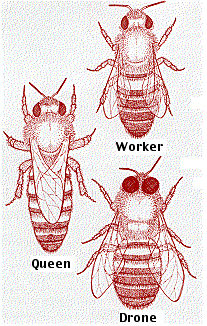 Apis mellifera commonly known as the domestic honey bee is a colonial insect living in hives that are made up of one queen (a fertile female), a few drones (males) and thousands of workers (infertile females). The workers are responsible for foraging for food namely nectar and pollen as well as tending to the young (2014). German ethologist Karl von Frisch’s (1886–1982) theorized that bees communicate the distance and the direction of food sources to each other via two kinds of dances: the round dance and tail-waggle dance (Munz, T. 2005), therefore indicating that bees exhibit a form of displacement when communicating with each other.
Apis mellifera commonly known as the domestic honey bee is a colonial insect living in hives that are made up of one queen (a fertile female), a few drones (males) and thousands of workers (infertile females). The workers are responsible for foraging for food namely nectar and pollen as well as tending to the young (2014). German ethologist Karl von Frisch’s (1886–1982) theorized that bees communicate the distance and the direction of food sources to each other via two kinds of dances: the round dance and tail-waggle dance (Munz, T. 2005), therefore indicating that bees exhibit a form of displacement when communicating with each other.
4.2.1.1 Round Dance
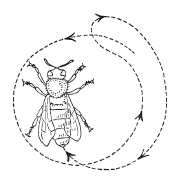 Round dance is usually performed when bees find food source which are less than 50 meters from their hives. Bees will run around in narrow circles before reversing direction to their original course. This may be repeated a few times at the same location or move to another location on the comb. Although a round dance communicates distance, it does not reflect the direction (R. Tarpy, D., n.d.).
Round dance is usually performed when bees find food source which are less than 50 meters from their hives. Bees will run around in narrow circles before reversing direction to their original course. This may be repeated a few times at the same location or move to another location on the comb. Although a round dance communicates distance, it does not reflect the direction (R. Tarpy, D., n.d.).
4.2.1.2 Waggle Dance
 Bees will perform the waggle dance in the shape of figure-eights when returning from sources which are located farther than 75 meters from their hives. Von Frisch mentioned that the frequency of turns in the dances varied inversely with the distance of foods while the straight runs of the dances indicated their direction of the food. He also found out that bees can detect polarized light and thus, oriented their dances and foraging flights with respect to the sun (Munz, T., 2005). Due to the directional information that is based upon the sun’s position, a forager’s dance for a particular resource will change during a day.
Bees will perform the waggle dance in the shape of figure-eights when returning from sources which are located farther than 75 meters from their hives. Von Frisch mentioned that the frequency of turns in the dances varied inversely with the distance of foods while the straight runs of the dances indicated their direction of the food. He also found out that bees can detect polarized light and thus, oriented their dances and foraging flights with respect to the sun (Munz, T., 2005). Due to the directional information that is based upon the sun’s position, a forager’s dance for a particular resource will change during a day.
4.2.2 Vervet Monkeys
 In addition, warning calls by the vervet monkey exhibit some level of semanticity as they produce distinctly different calls depending on the type of predator seen (Vagell, 2011a; 2011b). According to a 1980 experiment by Robert Seyfarth, Dorothy Cheney and Peter Marler, alarm calls for different types of predators sounded distinctly different and each call was able to elicit a distinct defensive response. When the leopard call was played, the subjects ran up into the trees while when eagle call were played, subjects looked up and run out of trees into lower bushes. When snake calls were played, subjects immediately stood on their hind legs and looked on the ground around them. Their calls however, show a lack of productivity as they only make warning calls that reflect the present situation and not in the past.
In addition, warning calls by the vervet monkey exhibit some level of semanticity as they produce distinctly different calls depending on the type of predator seen (Vagell, 2011a; 2011b). According to a 1980 experiment by Robert Seyfarth, Dorothy Cheney and Peter Marler, alarm calls for different types of predators sounded distinctly different and each call was able to elicit a distinct defensive response. When the leopard call was played, the subjects ran up into the trees while when eagle call were played, subjects looked up and run out of trees into lower bushes. When snake calls were played, subjects immediately stood on their hind legs and looked on the ground around them. Their calls however, show a lack of productivity as they only make warning calls that reflect the present situation and not in the past.
Here is a video that summarizes Seyfarth, Cheney and Marler’s (1980) research:
https://www.youtube.com/watch?t=188&v=3lsF83rHKFc
4.2.3 Elephants
 In 2006, keepers at Seoul’s Everland zoo were surprised when they heard Kosik, a 16-year-old elephant, talk. He had learned to talk by putting its trunk in its mouth and mimicking the words it heard from its caretakers: “yes,” “no,” “lie down,” “sit down,” and four other phrases in Korean. Scientists say that through Kosik they might be able to prove that elephants are capable of learning language, although it is unlikely that he understands the meaning of the words he expresses (Ilbonito, 2015). Such an occurrence is considerably rare and usually elephants will communicate by using gestures as well as “infrasounds” as explained below.
In 2006, keepers at Seoul’s Everland zoo were surprised when they heard Kosik, a 16-year-old elephant, talk. He had learned to talk by putting its trunk in its mouth and mimicking the words it heard from its caretakers: “yes,” “no,” “lie down,” “sit down,” and four other phrases in Korean. Scientists say that through Kosik they might be able to prove that elephants are capable of learning language, although it is unlikely that he understands the meaning of the words he expresses (Ilbonito, 2015). Such an occurrence is considerably rare and usually elephants will communicate by using gestures as well as “infrasounds” as explained below.
4.2.3.1 Gestures
 Biologist and conservationist Joyce Poole and her husband, Petter Granli, both of whom direct ElephantVoices, a charity they founded to research and advocate for conservation of elephants in various sanctuaries in Africa, have developed an online database decoding hundreds of distinct elephant signals and gestures. Poole and Granli have also deciphered the meaning of acoustic communication in elephants. Below are two forms of gestures that elephants commonly perform.
Biologist and conservationist Joyce Poole and her husband, Petter Granli, both of whom direct ElephantVoices, a charity they founded to research and advocate for conservation of elephants in various sanctuaries in Africa, have developed an online database decoding hundreds of distinct elephant signals and gestures. Poole and Granli have also deciphered the meaning of acoustic communication in elephants. Below are two forms of gestures that elephants commonly perform.
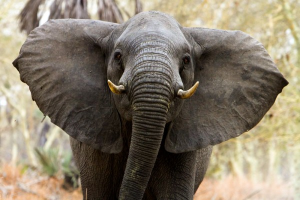 Aggression: Normally in such an aggressive stance, an elephant will hold its head well above its shoulders and with tusks lifted, direct its gaze at its provoker. An elephant may also increase its height by standing on a log or an anthill to assume greater stature, an approach used by males when they’re sizing each other up.
Aggression: Normally in such an aggressive stance, an elephant will hold its head well above its shoulders and with tusks lifted, direct its gaze at its provoker. An elephant may also increase its height by standing on a log or an anthill to assume greater stature, an approach used by males when they’re sizing each other up.
- Death: Elephants are empathetic towards one another by holding funerals for the dead (Wolchover, 2012). Elephants will try to rouse an injured or fallen elephants by using their tusks and trunk to try and feed a dead elephant, or appear to lift or even carry sick, dying, or dead elephants (Poole et al., 2015).
4.2.3.2 Infrasounds
 A team of voice researchers and biologists led by Christian Herbst, Angela Stoeger and Tecumseh Fitch has discovered that elephants produce “infrasounds” which are very low frequency sounds, far from the hearing compatibility of the average human being. One possibility as to how “infrasounds” are produced is when the elephants tense and relax the muscles in their larynx for each pulse of sound. Another possibility is that they are produced like human speech or singing. Because the elephant larynx is so large, they are extremely low in frequency. The “infrasounds” can travel several kilometers and provide elephants with a “private” communication medium that plays a pivotal role in elephants’ complex social life (2012).
A team of voice researchers and biologists led by Christian Herbst, Angela Stoeger and Tecumseh Fitch has discovered that elephants produce “infrasounds” which are very low frequency sounds, far from the hearing compatibility of the average human being. One possibility as to how “infrasounds” are produced is when the elephants tense and relax the muscles in their larynx for each pulse of sound. Another possibility is that they are produced like human speech or singing. Because the elephant larynx is so large, they are extremely low in frequency. The “infrasounds” can travel several kilometers and provide elephants with a “private” communication medium that plays a pivotal role in elephants’ complex social life (2012).
4.2.3.3 Elephant Calls in Fission-Fusion Societies
African Savannah elephants belong to a complex fission-fusion society, and vocal imitation is a useful form of acoustic communication which helps maintain individual-specific bonds without changing social groupings. Two studies conducted on these elephants lead to interesting instances of vocal imitation. The first case involved a ten-year-old adolescent female African elephant living in a semi-captive group of orphaned elephants in Kenya. Trucks could sometimes be heard from the elephant’s enclosure which was 3 kilometres away from the highway, and it was found that she emitted truck-like sounds that were different from the normal calls of African elephants. The second case involved a 23-year-old male African elephant who spent 18 years with 2 female Asian elephants in a zoo in Switzerland, and he was found to be producing chirping sounds typically produced by Asian elephants but not African elephants. It strengthens the idea that communicative demands of maintaining social relationships in fluid societies can lead to vocal learning (Fishlock & Lee, 2013).
4.2.4 Dolphins
Dolphins are highly sociable creatures, with a large brain relative to their body mass. Looking at the figure below, we see how the expansion of the dolphin’s brain almost mirrors that of human beings – with the introduction of a form of communication and socializing propelling it to growth.
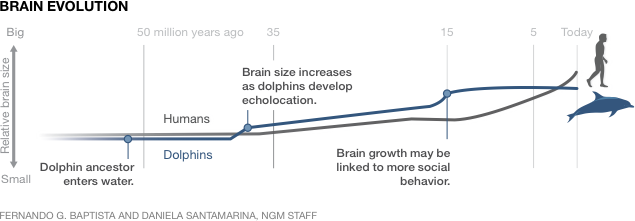
Most dolphins produce a variety of sounds described as clicks, whistles, buzzes, squawks, screams and barks (Herzing, 1996). Half a century of research has been dedicated to trying to decipher the languages that dolphins use, with not much progress. Scientists have not been able to determine the units that make up what might be an actual dolphin language. In recent times however, technology has allowed for the advancement of such research. Scientists have invented CHAT (cetacean hearing and telemetry), a machinery designed to not only record dolphins, but also produce their signature sounds as well other sounds that are dolphin-liked in nature. While at present, we are still in the dark about the possible language that the dolphins might hold, we know a decent amount of what their communication is capable of.
4.2.4.1 Clicking Noises In Isolation
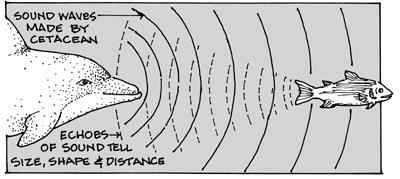 The echolocation sounds are short, broadband pulses (Evans, 1973) which are produced in low repetition rate trains or in high repetition rate bursts. Bursts of pulses can be used during prey capture (Verfuss et al., 1996) and during hostile interactions (Blomqvist & Amundin, 1998). The bottlenose dolphin uses echolocation clicks with a peak frequency between 115 and 121 kHz when recorded in open waters (Au, 1993). This mode of communication allows dolphins to navigate, recognize their friends and foes as well as escape from obstacles (Mary Cerullo, 2013).
The echolocation sounds are short, broadband pulses (Evans, 1973) which are produced in low repetition rate trains or in high repetition rate bursts. Bursts of pulses can be used during prey capture (Verfuss et al., 1996) and during hostile interactions (Blomqvist & Amundin, 1998). The bottlenose dolphin uses echolocation clicks with a peak frequency between 115 and 121 kHz when recorded in open waters (Au, 1993). This mode of communication allows dolphins to navigate, recognize their friends and foes as well as escape from obstacles (Mary Cerullo, 2013).
4.2.4.2 Whistling
 Whistles consist of narrow-band tones of constant frequency (CF) or tones that vary in frequency. Harmonic components are normally present (Popper, 1988). Dolphins use whistles to maintain contact within their pod or when meeting other pods of dolphins. Their whistles may indicate danger or a cry for help. Scientists think that each dolphin has its own unique whistle, almost akin to our names. Whistles may also help dolphins hunt cooperatively and coordinate migratory movements.
Whistles consist of narrow-band tones of constant frequency (CF) or tones that vary in frequency. Harmonic components are normally present (Popper, 1988). Dolphins use whistles to maintain contact within their pod or when meeting other pods of dolphins. Their whistles may indicate danger or a cry for help. Scientists think that each dolphin has its own unique whistle, almost akin to our names. Whistles may also help dolphins hunt cooperatively and coordinate migratory movements.
The whistles are used as a contact call when animals are out of visual range, and the possibilities of dolphin communication is made greater when combined with their imitation ability. Reports have been made that in Sarasota Bay, Florida, 43% of male calves and 10% of female calves developed signature whistles that were very similar to their mothers, but the question of whether signature whistle imitation in bottlenose dolphins is context-dependent remains inconclusive.
Herman in 2002 and 2006 trained bottlenose dolphins, a fission-fusion species to perform novel synchronous behaviours on command, and the study showed high levels of imitation with these dolphins. Interestingly, considerable research effort has failed to produce comparable skills in most non-human primates (Connor, 2007).
[Back to Table of Contents]
4.3 Further Research
Even though much research has been done on animal communication, more can be done to understand how and why different modes of vocalizations come about. One way to do so is to study the behaviour of animals in tightly knit social groups, such as dolphins and whales.
According to biologist Kathy Heise, resident killer whale communication is distinctly different from transient killer whales. The mode of communication employed by one group of whales does not seem to be mutually intelligible with the other. Future research on these “dialects” differing from family to family could help shed light on why dialect groups exist in human languages.
https://www.youtube.com/watch?v=-7E7FTSsbkg
To date, humans have not been able to fully bridge the gap with naturally sociable animals such as whales. Instead of trying to teach animals human language to understand how animals process language, humans could try to imitate and manipulate the sounds of animal vocalizations to see how these animals react to it. By manipulating and observing how animals react to these stimuli could help us eventually understand the exact meaning of their vocalizations. During a joint project by Australian telecommunications company Optus and the Humpback Acoustic Research Collaboration, a chamber orchestra was placed out in the sea while imitating sounds of a whale song, drawing the attention of curious humpback whales (Macleod, 2009). This shows us that there is the possibility of employing music as a communicative tool to bridge the language gap between animals and humans in order to shed some light on the acoustic properties of language.
[Back to Table of Contents]
4.4 Conclusion
Although there are some animals which seem to exhibit some forms of human language, animal and human communication are still a major contrast from each other. In the case of Kosik, for example, the question of whether the elephants are capable of expressive speech (as opposed to straight mimicry) has yet to be fully determined. .In conclusion, the use of human language is only unique to us and not only does it allow us to communicate with one another, it also allows us to form sentences with infinite variety and nonsensical yet understandable sentences.
A monkey can scream to warn others of an approaching predator, or alert them to tasty food source, but it cannot communicate something like “Doesn’t that hawk have a funny looking beak?” or “With a little salt, this fig would taste divine”. Jason G. Goldman, a science writer based in Los Angeles puts it simply:
Only humans are able to utter grammatical nonsense
While we continue to do further research as well as encounter new discoveries about animal communication, we seem to further and further establish the idea that our language – human language – is unique and much more expressive than any other form of communication found in the animal kingdom. We continue to attempt to teach animals our language, in a hope that one species will be able to adapt to it as well as we have, but continuously fall short in that regard. All signs seem to point towards the uniqueness of our language. However, as technology continues to improve, we begin to have more and more ways to decipher the current communication systems they have instead of teaching them our language. And maybe, just maybe, one of them will prove to us that we are not the only living creatures capable of what we consider to be language.
Of course, human language did not spring up suddenly, fully formed and fully versatile. The capacity for human language comes from a long line of evolution, with various stages and adaptations that all work together to form what we know today as Human Language. In the next part of the chapter, we will look at the evolution of human language; specifically, the evolution of the capacity of human language we now possess.
[Back to Table of Contents]
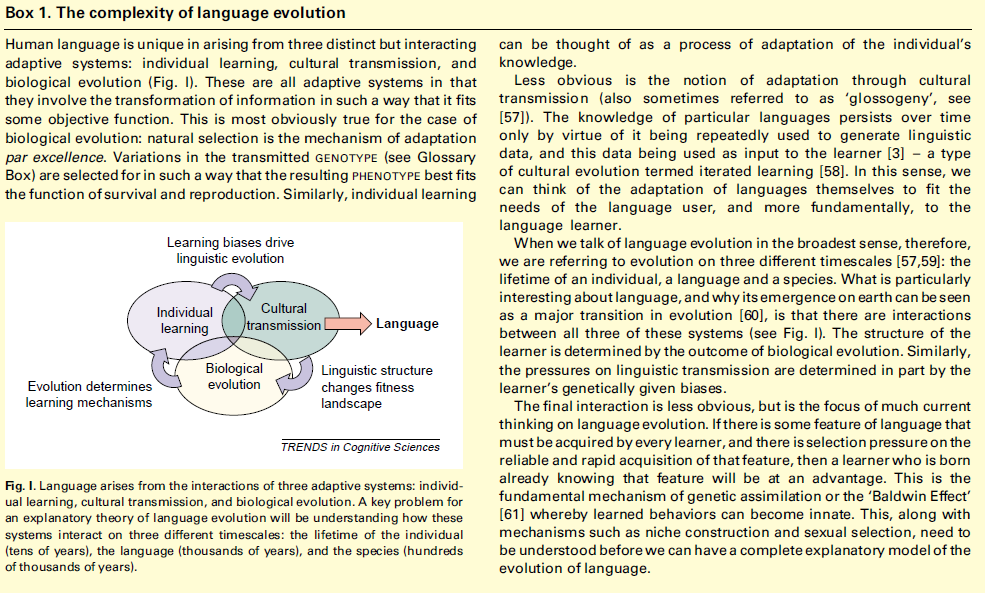
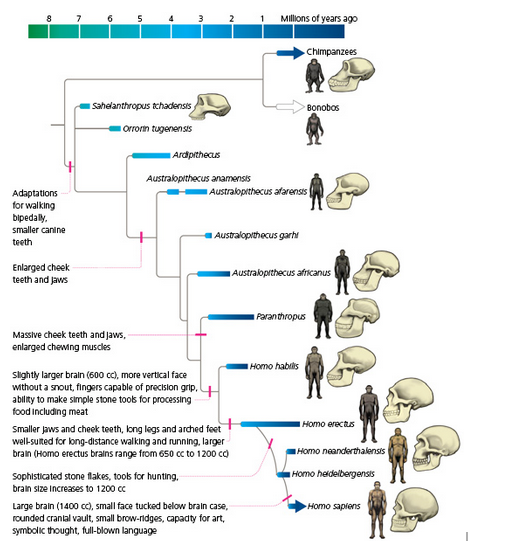

 Apis mellifera commonly known as the domestic honey bee is a colonial insect living in hives that are made up of one queen (a fertile female), a few drones (males) and thousands of workers (infertile females). The workers are responsible for foraging for food namely nectar and pollen as well as tending to the young (2014). German ethologist Karl von Frisch’s (1886–1982) theorized that bees communicate the distance and the direction of food sources to each other via two kinds of dances: the round dance and tail-waggle dance (Munz, T. 2005), therefore indicating that bees exhibit a form of displacement when communicating with each other.
Apis mellifera commonly known as the domestic honey bee is a colonial insect living in hives that are made up of one queen (a fertile female), a few drones (males) and thousands of workers (infertile females). The workers are responsible for foraging for food namely nectar and pollen as well as tending to the young (2014). German ethologist Karl von Frisch’s (1886–1982) theorized that bees communicate the distance and the direction of food sources to each other via two kinds of dances: the round dance and tail-waggle dance (Munz, T. 2005), therefore indicating that bees exhibit a form of displacement when communicating with each other.

 In addition, warning calls by the vervet monkey exhibit some level of semanticity as they produce distinctly different calls depending on the type of predator seen (Vagell, 2011a; 2011b). According to a 1980 experiment by Robert Seyfarth, Dorothy Cheney and Peter Marler, alarm calls for different types of predators sounded distinctly different and each call was able to elicit a distinct defensive response. When the leopard call was played, the subjects ran up into the trees while when eagle call were played, subjects looked up and run out of trees into lower bushes. When snake calls were played, subjects immediately stood on their hind legs and looked on the ground around them. Their calls however, show a lack of productivity as they only make warning calls that reflect the present situation and not in the past.
In addition, warning calls by the vervet monkey exhibit some level of semanticity as they produce distinctly different calls depending on the type of predator seen (Vagell, 2011a; 2011b). According to a 1980 experiment by Robert Seyfarth, Dorothy Cheney and Peter Marler, alarm calls for different types of predators sounded distinctly different and each call was able to elicit a distinct defensive response. When the leopard call was played, the subjects ran up into the trees while when eagle call were played, subjects looked up and run out of trees into lower bushes. When snake calls were played, subjects immediately stood on their hind legs and looked on the ground around them. Their calls however, show a lack of productivity as they only make warning calls that reflect the present situation and not in the past.
 Biologist and conservationist Joyce Poole and her husband, Petter Granli, both of whom direct
Biologist and conservationist Joyce Poole and her husband, Petter Granli, both of whom direct 




